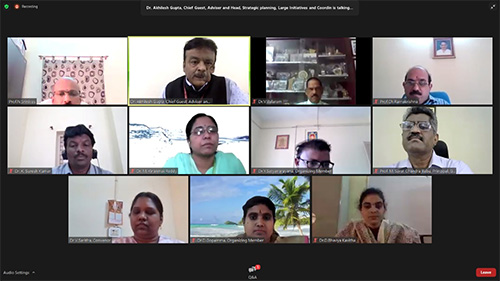 Climate change which impacts five big international priorities - water, health, environment, agriculture and energy is being addressed by focusing on glaciology, climate modelling, urban climate, aerosol studies, extreme events and Himalayan ecosystem studies, Adviser & Head, Climate Change Programme, Department of Science & Technology (DST), Dr Akhilesh Gupta said at a webinar on 22 March 2021.
Climate change which impacts five big international priorities - water, health, environment, agriculture and energy is being addressed by focusing on glaciology, climate modelling, urban climate, aerosol studies, extreme events and Himalayan ecosystem studies, Adviser & Head, Climate Change Programme, Department of Science & Technology (DST), Dr Akhilesh Gupta said at a webinar on 22 March 2021.
Dr Gupta elaborated on the impacts of climate change and DST’s plans to address them over the next five years by fixing priority areas of action at the National E-webinar organized to observe the World Water Day 2021.
“Temperature is increasing and will continue to increase, and sea level will also continue to increase if climate change remains un-arrested. Cities in the countries are showing higher intensity of rainfall due to their high population density. Number of flash floods is increasing along with variability of rainfall. Aerosols are altering rainfall patterns owing to complex aerosols-cloud interaction processes”, he said.
“Not all EI Ninos cause droughts, and not all droughts are caused by EI Nino”. Citing a recent study published in the Science by an IISc scientist supported by DST, Dr Gupta, mentioned that “These two types of monsoon droughts are different not only in their oceanic markets but also in the seasonal evolution. Rather than a signature in the pacific, surface temperatures are observed to be anomalously cold in the North Atlantic during EI Nine draughts. In EI Nino drought, once rainfall deficit sets in early in the season, around mid-June, it progressively gets worse; by mid-August, the entire country is in large deficit, and there is no going back. In non-EI Nino droughts, there is an initial moderate deficit in June. During mid-July to mid-August, the monsoon, in fact, shows signs of recovery. However, around the third week of August, the buildup of deficit begins yet again, and within three weeks, nearly the entire country is covered in deficit,” he said.
Dr Gupta said that all Indian states are vulnerable to climate change. “Jharkhand is India’s most vulnerable and Maharashtra the least. Top 8 most vulnerable states are Jharkhand, Mizoram, Orissa, Chhattisgarh, Assam, Bihar, Arunachal Pradesh and West Bengal. Nearly 90 per cent districts in Assam, 80 per cent in Bihar and 60 per cent in Jharkhand are highly vulnerable,” Dr Gupta pointed out.
He added that in an effort to tackle such problems, DST’s climate change programme has produced 1500 research papers, out of which more than 1000 are in the international journals, developed 100 new techniques, conducted 350 workshops, organised 250 state-level training programmes wherein 50,000 people are trained, built capacity among students, scholars and researchers and organized Public Awareness Programmes in which over 1.5 lakh people are given exposure.
Several dignitaries including Prof K. Siva Rama Krishna, Vice-Chancellor, GITAM, Prof Jayasankar Variyar, Pro-Vice-Chancellor, GITAM, Prof A. Subrahmanyam, Dean of Sciences, GITAM and Prof M. Saratchandra Babu, Principal, GIS, GITAM participated in the National E-webinar on- World Water Day - 2021 on the theme Valuing Water organised by Department of Environment Science, GITAM Institute of Science Vishakhapatnam. They highlighted problems about the scarcity of potable water and increasing concerns on water supply due to population increase.


























